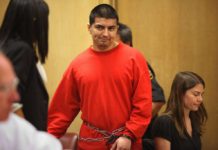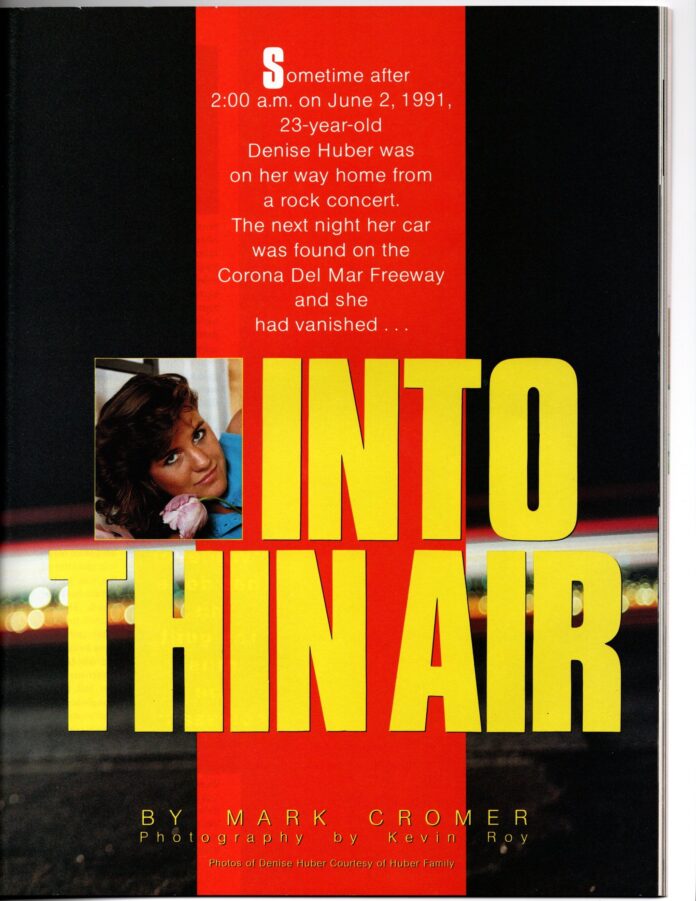
Sometime after 2:00 a.m. on June 2, 1991, 23-year-old Denise Huber was on her way home from a rock concert. The next night her car was found on the Corona Del Mar Freeway and she had vanished…
[This was first published thirty years ago by Southern California Magazine in June 1992, on the first anniversary of Denise Huber’s disappearance. In July 1994, her body was discovered frozen solid inside a freezer kept running in a stolen moving truck that was parked in the backyard of John Famalaro in Yavapai County, Arizona. She was still handcuffed and gagged. In 1997 Famalaro was tried for capital murder in Orange County, California, convicted and sentenced to death. In a unanimous decision in 2011, the California Supreme Court upheld Famalaro’s sentence. Now in his mid-60s, Famalaro remains on Death Row today, where despite overwhelming support by California voters for the death penalty, Governor Gavin Newsom has proudly declared that no convicted killer will be executed on his watch.]
By Mark Cromer
It was a night Denise Huber was looking forward to. She and a friend had lucked into some concert tickets. Denise had a penchant for England and the alternative music scene it had spawned, and the prospect of seeing the British rock artist Morrissey was a chance she just couldn’t say no to.
Her adrenalin had already started to surge as she got ready for the concert that Sunday afternoon, picking her clothes out carefully. She chose a short skirt hiked up tight on her 130-pound frame, and a low-cut purple satin blouse. Big earrings and black nylon panty hose rounded out the look she wanted that night. A little racy perhaps, but standard female fare for a rock show.
Denise trotted out the door of her family’s Newport Beach home sometime around 7 p.m., stopping only long enough to shout upstairs to her parents that she was leaving.
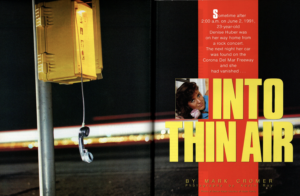
It didn’t take her long to arrive at Rob Calvert’s home in Huntington Beach, the friend she was going to the concert with. Calvert’s car was on its last legs and would have proved to be a risky ride. Denise offered to drive.
The sun was starting to crest as the two left Calvert’s house. It was close to 7:30 p.m.
Rob remembers they made only one stop on the way to the Forum in Inglewood. Denise wanted to get a little partying done before going inside the cavernous concert hall, where a single beer can cost more than a six pack.
A quick stop at a liquor store produced a bottle of vodka and some orange juice.

A short while later the two were doing shooters in the Forum’s parking lot, getting a little amped before the show. It was a warm, dry summer night. The kind seductions are of, but Denise and Rob were just friends and they passed the time and bottle over talk about the music they liked and their lives.
Once inside the Forum, Rob recalls that Denise did not go unappreciated. Her revealing outfit proved to be luring when mixed with her girl-next-door looks, and a lot of guys in the crowd let their eyes do the walking.
The two bought some more beer and settled back into their seats for the show.
When the lights came back up it wasn’t quite midnight yet, and even though it was a Sunday, the two decided to wind the night down over a couple of beers at their favorite cantina, the El Paso in Long Beach. It was only a short trip up Pacific Coast Highway.
At the El Paso, Rob ordered one round of Miller Lites; she ordered the next.
During their nightcap Denise saw a guy named Ross that she knew, and he joined the two for drinks. Ross wanted Denise to split with him, but being Rob’s ride home, she declined.
As last call approached the three decided it was time to call it a night and head for home. Ross and Denise had a few more words between them in the parking lot, out of earshot from Rob, then Ross went his own way and Denise and Rob started the jaunt back to Huntington Beach.
They stopped briefly at a 7-Eleven along PCH, just long enough for Rob to buy her a pack of Marlboro Light cigarettes.
He remembers the final moments fairly well.
“We pulled in front of my house. I told her goodnight, and that I would call her the next week,” he said.
It was close to 2 a.m.
Rob Calvert walked inside his mother’s home and promptly crashed in his bed.
Denise turned her car back toward Newport Beach, less than a dozen miles away.
She never made it.
Twenty hours later, her 1988 Honda Accord was found on the southbound shoulder of the Corona Del Mar Freeway. The car’s right rear tire was blown out.
Denise’s purse and keys were gone, and so was she.
When Ione and Dennis Huber awoke Monday morning, they thought it was unusual that Denise was not in her bed, still asleep. Unusual, but not alarming.
At age 23, Denise came and went as she pleased. She had been living at home primarily because she was saving for a trip to England.
Besides, Denise was a bright young woman. A UC Irvine grad who was holding down two jobs. The kind of person neighbors and acquaintances would call “responsible” and “trustworthy.”
“Of our two kids, she was the one with no problems. She was the compliant one,” her mother would say later.
If she hadn’t come home it was probably because she was too tired or had had too much to drink.
Her mother remembers the slow progression of events the Monday would bring.
“We thought maybe she had stayed over at a friend’s house. But then she didn’t call,” Ione said. The Hubers went to work, knowing that when they returned home that afternoon they’d find Denise there, life continuing as it had and always would.
Except this time.
“I came home and she wasn’t here, she hadn’t called…. I knew something was wrong,” Ione said.
After checking with Denise’s friends again, Ione called several area police departments, checking on local traffic accidents that had been reported over the last 24 hours.
Then Ione called Newport PD and filed a “missing person’s” report.
Almost four hours later, close to 10:00 Monday night, June 3, 1991, the phone rang. Denise’s best friend, Tammy Brown, was on the other end. She had just found Denise’s car on the Corona Del Mar Freeway.
Dennis and Ione jumped in their car and headed for the location where Tammy told them she had found the car.
It wasn’t long before they could see it in their headlights. Sitting there like a large, empty shell, stranded on the side of the road.
“I was sick…. I knew, I just knew. Before, you hope; but when we found her car… I just knew,” Ione said.
As he talks about it now, one can tell Dennis can still see his daughter’s car on the freeway shoulder. Like Tammy, he was probably afraid to walk up to it and look inside, afraid of what he might find.
What eats at his soul now, however, is what he did not find.
“That’s when the nightmare began.”
The nightmare is now a year old.
And Dennis and Ione Huber have lived it every day since their only daughter was, by every estimate, abducted from a semi-remote stretch of freeway in the Southland.
Denise is now one face among more than 2,600 others who were reported missing in California last year. According to the California Department of Justice, nearly a third of those cases were missing adults.
Ivan Azevedo, an assistant manager with the state Attorney General’s Office missing person’s unit, said “stranger” abductions is the smallest category, appearing only occasionally in the agency’s files. Between 1964 and early 1992, only 13 adults have been reported abducted by strangers. Yet only two of those cases have been solved.
Another ominous category that has a higher body count is “suspicious circumstances,” which Huber is currently classified under. There have been nearly 500 people in California who have disappeared since 1961 that authorities have classified as suspicious. Nearly 300 of those cases are still unsolved.
Those are facts not lost on the Hubers.
“Every time a body is found, we start to wonder… it’s not an easy thing to go through,” Ione says as she sits across from her husband, carefully watching him react to her words. “It changes your life.”
In the year since their daughter’s disappearance, the level of frustration has at times been almost unbearable.
“Not knowing is the worst part. I haven’t given up hope that she is alive, though I have tried to prepare for the worst. You can’t put it behind you, it doesn’t go away. And I don’t see that it ever will,” Ione says.
The Hubers’ life, once ordinary and rather uncomplicated, now centers upon trying to solve the mystery that surrounds Denise’s disappearance. A large flier campaign has blanketed Orange County with police bulletins that are adorned with Denise’s face. Bumper stickers can be seen on cars throughout the county asking, “Have you seen Denise?”
Dennis and Ione’s answering machine now opens with “We will accept a collect call from Denise Huber.”
Calvert, who had known Denise as a friend for the past several years, remains mystified as to what happened that night after she dropped him off at home. It wasn’t until early Tuesday morning, on June 4th, that he got a wake-up call from Costa Mesa police.
“I got a call around 2 a.m. They said, ‘Rob Calvert?’ and I said ‘Yeah.’ They said, ‘Go to the door, we have a detective at your door.’
“The detective comes in and starts asking a bunch of questions about what she was wearing, then in the middle of the questions he says, ‘Oh, by the way, we found her car at the side of the road, abandoned, with a blown-out tire.’ That’s when I knew something happened.”
Calvert was called downtown for questioning later that day, but doesn’t think he was able to help much, as nothing appeared out of the ordinary the night of June 2 that he could remember.
Investigators have said as far as they can tell Calvert’s story checks out.
“They never said outright that I was a suspect,” he said.
As he walks along the Newport shoreline months after Denise vanished, Calvert watches the breakers come in and thinks about all the “What ifs” and “Should haves” that have probably plagued him longer than he cares to admit.
“There is always that feeling if something had been different, if maybe I had been more aware that night, that this would not have happened,” Calvert said, his voice giving way to an edge of resignation.
“Whoever has done this, the guilt must be colossal.”
Calvert has moved on with his life. At first active in the search for Denise, he now is only in occasional contact with the Hubers. But the girl with the long legs and knock-out smile has far from faded in his memory.
“She was special… radiant. A friend who was not hung up on herself.”
Tammy Brown met Denise at UC Irvine during the late ‘80s and struck up a close friendship with her that lasted until Denise disappeared. Like Calvert, Brown said she is mystified as to what happened to the girl she so looked up to for an example of self-confidence and esteem. The friend she talked with everyday.
And like Calvert, there are some now eerie memories etched in her mind.
Like talking with Denise late that Sunday afternoon.
“I said call me tomorrow and let me know how everything went.”
As events began to unfold Monday, Brown said she slowly developed a feeling something bad had happened. She just didn’t know she would be the one to discover how bad indeed things had happened.
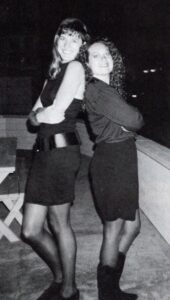
Brown discovered Denise’s car on the side of the freeway that Monday night, while driving back from her boyfriend’s work. Strangely enough, Brown recalls she had a sense she might find her friend’s car and was looking for it.
“I had a gut feeling I was going to find her car,” she said. “Then all of a sudden I saw it… 2JVV (numbers on the car’s license plate) …I just started screaming.”
Brown said she kept driving until she got a phone, where she called the Hubers and told them she found the car. Then she drove back to the spot on the freeway.
“I looked at the car, But I didn’t want to. I didn’t want to find anything.
“I looked down the ravine, again afraid of what I might find.”
Since that night she has mulled over every little thing she can remember, to the point now where she no longer wants to.
“I have changed my thoughts about it so many times, I stopped thinking about it because it was making me sick.”
At first content to let the Costa Mesa Police Department who has jurisdiction over the case, handle the investigation, by September the Hubers had retained the firm of Clarke International Investigations.
A private detective who has been known to ruffle the feathers of law enforcement agencies, Logan Clarke wasted little time before he blasted the Costa Mesa PD investigation, which he says was bungled from the start.
“They just blew ‘Home Room 101’ investigation-type things. I think they missed a lot of things and I think they assumed a lot of things,” Clarke said.
The first major error the police detectives made on the case, Clarke said, was in assuming it was a standard missing person’s case, the kind where the individual shows up within a day or two.
As a result, Clarke said, vital evidence in Denise’s case was overlooked or neglected.
“When they discovered it was a righteous kidnapping, they found that they hadn’t done the background that they needed to do, which hampered all of our investigation,” he said.
His voice rising to the point of near indignation, Clarke recites a litany of mistakes he said the detectives made early on in their investigation. Things like documenting if the Accord’s emergency flashers or lights had been on while it sat on the freeway shoulder. Or if the driver’s seat had been adjusted, which could help determine if someone else had been in the driver’s seat that night.
“We would ask them these questions and they would look at us with these blank stares,” Clarke said, adding, “They didn’t expect that car on the side of the road to be their biggest can of worms in 10 years.”
There were other foul-ups, Clarke maintains, such as printing items recovered from her car as well as not dusting Denise’s room for copies of her own fingerprints until months later.
“I brought this up, how many months later, and then they go back and print her room,” Clarke said, noting by that time Denise’s younger brother had moved into it.
In fact, Costa Mesa PD did have the Accord sent to a crime lab in Santa Ana, where lasers were used to recover whatever prints or evidence was in the car. According to investigators, both a shot glass found in the car and items in Denise’s room did provide prints. Yet those discoveries are probably a moot point by now, because if Denise was killed, identification will be made using dental charts or other methods.
Perhaps one of the biggest questions surrounding the case is why, if the car sat on the shoulder of the freeway for an entire weekday as well as most of that night, was it not spotted and tagged by the California Highway Patrol?
Angel Johnson, a CHP officer familiar with the case, said the CHP patrols various “beats” in three shifts over a 24-hour period. Officers assigned to each beat are required to check their entire beat at the beginning and end of each shift.
If that’s true, it means that at least six CHP patrol cars drove right by Denise’s car without stopping. That is, if Denise’s car was really there between 2 a.m. and 10 p.m. Monday.
Clarke said he believes there is a “50-50” chance Denise was abducted elsewhere, then her car dumped on the freeway to make it appear she had broken down there.
If true, that scenario could explain why the CHP did not see and tag the car during their rounds.
Clarke said he believes the tire on Denise’s car may have had the air let out of it purposely, shortly before the blow-out. Like all the other theories that surround this case, while it may help answer one question, it raises several dozen more.
Had someone tampered with her car and then followed her from the Forum or the cantina? If so, how could they be sure the tire would blow before she reached home?
Or did someone, as Clarke suggests, abduct Denise elsewhere, before letting most of the air out of her tire and then driving it until it finally exploded, then ditching the car on the freeway.
Again, Clarke said it is impossible to know now because of mistakes he believes Costa Mesa detectives made.
“Their investigation was so piss-poor it’s impossible to tell at this point,” he said.
Sgt. Ron Smith has heard these assertions and more from Clarke, but he dismisses them point blank as nothing more than fanfare from a P.I. more concerned about drumming up publicity for himself than finding his client’s daughter.
“They [Clarke International] were really irresponsible in some things they have said,” Smith notes, adding, “They took the low road. Within two weeks of being on the case they said they were 80 percent certain they knew who did it. We have never been 80 percent certain of anything other than she is missing.”
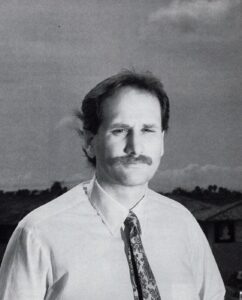
Smith, who oversees the Costa Mesa Police Department’s detective bureau, said Clarke also accused the police of covering up evidence in the case, alluding that a police officer may have been involved in Denise’s disappearance.
Clarke said it is a theory he still believes.
“My personal opinion is that it involves a police officer or someone impersonating a police officer,” he said, adding, “I have been told by sources that it is part of their investigation, and that they have a suspect in mind.”
If that is true the detectives working the case haven’t let on.
Detective Lynda Giesler is a 29-year department vet who has worked more missing persons cases over the years than she’d care to remember. She now heads the team of detectives who are searching for Denise.
As she looks out across the lanes of traffic zipping by on the Corona Del Mar Freeway, from the same spot where Denise’s car was found, Giesler said she has two basic theories of what occurred in the early morning hours of June 3rd.
Both of them boil down to Denise simply being in the wrong place at the wrong time.
“My gut feeling is that someone came along and took her by force, outside of the car,” Giesler said, noting there was no evidence that there had been a struggle inside the car. “Either that or someone came by and seemed nice, clean-cut, and she made a judgement call… and she made the wrong one.”
If Denise’s abduction, and presumably murder, was indeed more spontaneous than planned, then Giesler and her co-workers face some daunting obstacles in solving the case.
“We could be developing a scene where someone really stopped to help and it just went bad from there,” she said. “That’s what makes this case so difficult. She may have been killed by someone who has not killed before and will not kill again.”
Whether it was a Good Samaritan-turned-killer or a night stalker who just got lucky and found a vulnerable young woman, it’s still anyone’s guess as to what was done with her body.
“Again, where do you start?” Giesler asks. “Where do you begin an organized search? As mobile as things are today, she may have been picked up here, killed somewhere else and dumped in Arizona or New Mexico. How far do you want to go? How far do you want to drive?”
Giesler believes Denise was not on the side of the freeway for very long, noting that CHP records indicate neither of the two call boxes closest to Denise’s car had been used that night.
Johnson confirmed that all roadside calls made from call boxes on that stretch of freeway are routed through the CHP’s Santa Ana office and are recorded on both tape and dispatch cards.
A lone female caller would be given a priority status, Johnson said, with the CHP dispatching both a tow truck and an officer to the scene. The Accord’s trunk was also undisturbed, Giesler said, giving no indication there had been any attempt to use the spare tire.
Clarke agrees that if Denise did break down on the freeway and was abducted there, chances are it happened very quickly.
“Bang! Right there,” Clarke said, adding he doubted she could have been there longer than three minutes before getting into, or being dragged into, another car.
One of the other issues in the case Clarke and Costa Mesa’s detectives seem to agree on is whether Denise may have disappeared on her own free will. Smith admits that it was one of dozens of possibilities that was considered early on, but said there simply isn’t any indication that Denise decided to hit the road for parts unknown.
Giesler points out that Denise was carrying several credit cards in her purse when she vanished. There has been no activity on the cards since. Her savings account has also remained untouched. And there hasn’t been any evidence that Denise would have been motivated to disappear quickly and without a trace. No history of family abuse, drug problems or any serious enemies.
While Clarke, along with Smith and Giesler, does not totally dismiss the idea that Denise may still be alive and in captivity somewhere, the possibilities appear rather slim.
In October a massive search was mounted through nearby Bonita Canyon that covered areas such as the marshlands of the Back Bay behind UCI, where a killer may have hastily tried to dispose of a body. Searchers even used poles to thrust several feet down in the ground in some areas, looking for a grave.
Yet the scores of Orange County Search and Rescue team members and volunteers failed to turn up either Denise or anything she would have had with her that night.
The fact that a body, or at this point even bones, have not turned up is unusual, Giesler said.
“Usually a body is found fairly quickly…. It is very rare to not have a homicide body discovered early on,” she said, whether in a shallow grave, in a dumpster behind the local convenience store or on a roadside.
But Gielser and her team plod on, continuing the search. Psychics have been brought to the spot where Denise’s car was found, yet failed to produce any significant leads. The television exposure of the case has brought increased attention and is generally followed by calls that run something like, “Yeah, I saw that Denise Huber thing on America’s Most Wanted, and uhh, well, I think that girl is living with my buddy Joey Blitz, year, I saw ‘em together at the Tastee Freez down the road here and…”
Despite the fact that investigators apparently know little more about what happened to Denise Huber today than they did a year ago, the case is far from finding itself collecting dust in some basement filing cabinet.
“We’re eight months into it and we are nowhere close to filing it. It is our foremost case; we work it everyday,” she said.
And though critics such as Clarke, who is still on retainer to the family, may have flared a few tempers at Costa Mesa PD, the Hubers themselves praise the police for working the case hard.
Yet for Dennis and Ione, their life remains on hold.
And the waiting continues.



